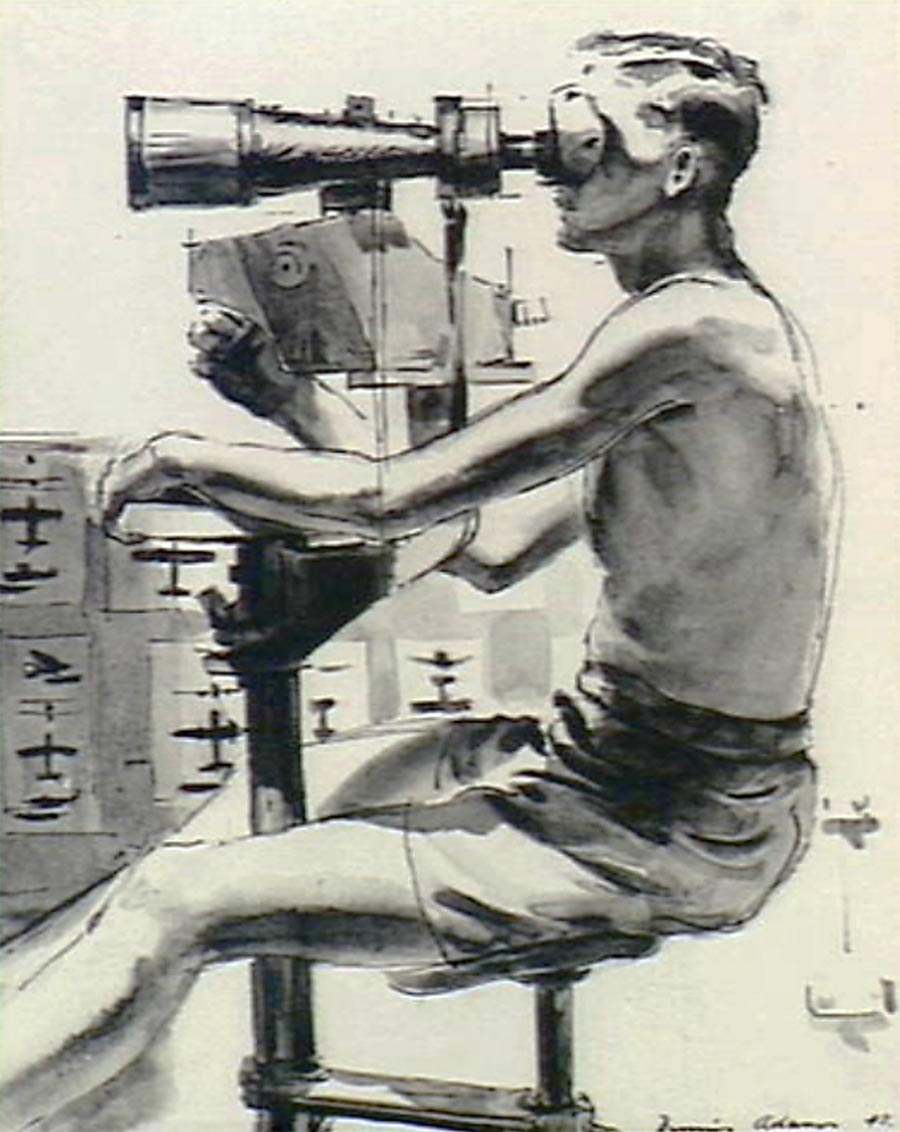Starboard lookout, HMAS Arunta (l)

The Tribal class destroyers such as Arunta have lookout positions on either side of the bridge. These are combination swivel seats with a bracket to hold the binoculars. Lookouts are relieved at least every half hour to prevent fatigue. Their duties are to search the sea and sky and report anything unusual seen from right ahead to right abeam. On the inside of the plating of this position silhouettes of aircraft have been posted to assist the lookout to identify aircraft.
- About Dennis Adams
Dennis Adams was born in Sydney but when his father, a marine engineer, retired from the sea the family moved to a sheep farm in Queensland. Stories of adventures at sea gave him a desire to experience life on the oceangoing sailing vessels. When the family visited Sydney Dennis was taken to see the magnificent windjammers enter the Heads – linking Australia with ‘the rest of the world’.
Adams demonstrated that he was a gifted draftsman and when he finished school was accepted as a student at the Julian Ashton School of Art in Sydney. After completing his Art studies, the 20-year-old Adams lived in Sydney and worked as a commercial artist with artists such as William Dobell and Lloyd Rees.
Adams had two desires. One was to continue his art studies at the Royal Academy of Art in London - the other was to sail on one of the windjammers that he had seen entering Sydney Harbour when he was a lad.
By the 1930s many of the windjammers coming to Australia now only visited South Australian ports so in 1935 Adams moved to South Australia and signed on as an ‘able-bodied passenger’ on the Herzogin Cecilie.
Adams, joined the port watch and lived and worked in the fo’c’s’le. He made a pictorial record of life on a windjammer. His quick oil sketches chronicled the crew as they set or reduced sail as well as completing important maintenance tasks on board.
Adams arrived in Falmouth in 1935 with his oil sketches on sail canvas and headed for London to enrol at the Royal Academy of Arts. He spent several years studying art at the Royal Arts School, with its emphasis on life drawing and figurative work.
Iin 1939 Adams returned to Australia on Erikson’s Lawhill. Like when he was on Herzogin Cecilie he made many quick oil sketches of the crew at work on the ship.
On his return to Australia Adams enlisted as a solider in the 18th Battalion and was later seconded to the Department of Home Security for camouflage work. In 1942 he was appointed an official war artist to represent the activities of the Australian and US Navies and the merchant marine in the South Pacific.
After WWII Adams established a career as an artist specialising mainly in maritime and war art. Adams also taught art at the East Sydney Technical College. He completed numerous public works of sculptural art, many in bronze.
In 1989, Dennis Adams was awarded the Order of Australia Medal for his contributions to the arts.
- About HMAS Arunta (I)Sailors at work
Since entering World War 1 in 1914 with 16 ships, two submarines and 3800 RAN personnel (including 850 from the Royal Navy) the number of serving personnel in the Royal Australian Navy has fluctuated depending on the strategic and shifting financial environment. Over more than a century, the RAN’s and people have seen action in every ocean of the world.
Of the tens of thousands who have served, 2658 members have made the ultimate sacrifice defending Australia’s interests in warlike and peacetime operations across the globe.
Fortunately, for the vast majority who served in periods of peace or survived periods of hostilities the experience was positive.
In addition to their service in a particular category which involved specific duties, they also participated in communal duties such as coaling ship. Thus, the artworks included in this section relate to a mix of specialist and communal activities.
More reading
- Additional resources for Dennis Adams
- Additional resources for HMAS Arunta (I)Sailors at work



